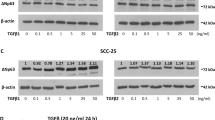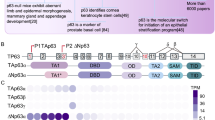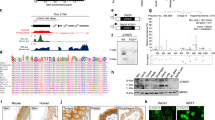Abstract
ΔNp63 is a transcription factor that is critical for the development of stratified epithelia and is overexpressed or amplified in >80% of squamous cell carcinomas (SCCs). We identified the RING finger E3 ubiquitin ligase PIR2/Rnf144b as a direct transcriptional target of ΔNp63α and showed that its expression parallels that of ΔNp63α in keratinocytes, SCC cell lines and SCCs. We used primary keratinocytes as a model system to investigate the function of PIR2/Rnf144b in stratified epithelia. Depletion of PIR2/Rnf144b severely impaired keratinocyte proliferation and differentiation, associated with accumulation of p21WAF1/CIP1; a known target of PIR2/Rnf144b. More importantly, we found that PIR2/Rnf144b binds and mediates proteasomal degradation of ΔNp63α, generating a hitherto unknown auto-regulatory feedback loop. These findings substantiate PIR2/Rnf144b as a potentially critical component of epithelial homeostasis, acting downstream of ΔNp63α to regulate cellular levels of p21WAF1/CIP1 and ΔNp63α.
This is a preview of subscription content, access via your institution
Access options
Subscribe to this journal
Receive 50 print issues and online access
$259.00 per year
only $5.18 per issue
Buy this article
- Purchase on Springer Link
- Instant access to full article PDF
Prices may be subject to local taxes which are calculated during checkout






Similar content being viewed by others
References
Westra WH . The changing face of head and neck cancer in the 21st century: the impact of HPV on the epidemiology and pathology of oral cancer. Head Neck Pathol 2009; 3: 78–81.
Hibi K, Trink B, Patturajan M, Westra WH, Caballero OL, Hill DE et al. AIS is an oncogene amplified in squamous cell carcinoma. Proc Natl Acad Sci USA 2000; 97: 5462–5467.
Sniezek JC, Matheny KE, Westfall MD, Pietenpol JA . Dominant negative p63 isoform expression in head and neck squamous cell carcinoma. Laryngoscope 2004; 114: 2063–2072.
Vanbokhoven H, Melino G, Candi E, Declercq W . p63, a story of mice and men. J Invest Dermatol 2011; 131: 1196–1207.
Mills AA, Zheng B, Wang XJ, Vogel H, Roop DR, Bradley A . p63 is a p53 homologue required for limb and epidermal morphogenesis. Nature 1999; 398: 708–713.
Suh EK, Yang A, Kettenbach A, Bamberger C, Michaelis AH, Zhu Z et al. p63 protects the female germ line during meiotic arrest. Nature 2006; 444: 624–628.
Yang A, Schweitzer R, Sun D, Kaghad M, Walker N, Bronson RT et al. p63 is essential for regenerative proliferation in limb, craniofacial and epithelial development. Nature 1999; 398: 714–718.
Candi E, Rufini A, Terrinoni A, Dinsdale D, Ranalli M, Paradisi A et al. Differential roles of p63 isoforms in epidermal development: selective genetic complementation in p63 null mice. Cell Death Differ 2006; 13: 1037–1047.
Graziano V, De Laurenzi V . Role of p63 in cancer development. Biochim Biophys Acta 2011; 1816: 57–66.
Deyoung MP, Ellisen LW . p63 and p73 in human cancer: defining the network. Oncogene 2007; 26: 5169–5183.
Rocco JW, Leong CO, Kuperwasser N, DeYoung MP, Ellisen LW . p63 mediates survival in squamous cell carcinoma by suppression of p73-dependent apoptosis. Cancer Cell 2006; 9: 45–56.
Di Cunto F, Topley G, Calautti E, Hsiao J, Ong L, Seth PK et al. Inhibitory function of p21Cip1/WAF1 in differentiation of primary mouse keratinocytes independent of cell cycle control. Science 1998; 280: 1069–1072.
Abbas T, Dutta A . p21 in cancer: intricate networks and multiple activities. Nat Rev Cancer 2009; 9: 400–414.
Candi E, Schmidt R, Melino G . The cornified envelope: a model of cell death in the skin. Nat Rev Mol Cell Biol 2005; 6: 328–340.
Blanpain C, Fuchs E . Epidermal homeostasis: a balancing act of stem cells in the skin. Nat Rev Mol Cell Biol 2009; 10: 207–217.
Watt FM, Lo Celso C, Silva-Vargas V . Epidermal stem cells: an update. Curr Opin Genet Dev 2006; 16: 518–524.
Sayan BS, Yang AL, Conforti F, Tucci P, Piro MC, Browne GJ et al. Differential control of TAp73 and DeltaNp73 protein stability by the ring finger ubiquitin ligase PIR2. Proc Natl Acad Sci USA 2010; 107: 12877–12882.
Huang J, Xu LG, Liu T, Zhai Z, Shu HB . The p53-inducible E3 ubiquitin ligase p53RFP induces p53-dependent apoptosis. FEBS Lett 2006; 580: 940–947.
Ng CC, Arakawa H, Fukuda S, Kondoh H, Nakamura Y . p53RFP, a p53-inducible RING-finger protein, regulates the stability of p21WAF1. Oncogene 2003; 22: 4449–4458.
Benard G, Neutzner A, Peng G, Wang C, Livak F, Youle RJ et al. IBRDC2, an IBR-type E3 ubiquitin ligase, is a regulatory factor for Bax and apoptosis activation. EMBO J 2010; 29: 1458–1471.
Sayan AE, D'Angelo B, Sayan BS, Tucci P, Cimini A, Ceru MP et al. p73 and p63 regulate the expression of fibroblast growth factor receptor 3. Biochem Biophys Res Commun 2010; 394: 824–828.
Nguyen BC, Lefort K, Mandinova A, Antonini D, Devgan V, Della Gatta G et al. Cross-regulation between Notch and p63 in keratinocyte commitment to differentiation. Genes Dev 2006; 20: 1028–1042.
Truong AB, Kretz M, Ridky TW, Kimmel R, Khavari PA . p63 regulates proliferation and differentiation of developmentally mature keratinocytes. Genes Dev 2006; 20: 3185–3197.
Ciechanover A . Proteolysis: from the lysosome to ubiquitin and the proteasome. Nat Rev Mol Cell Biol 2005; 6: 79–87.
Ciechanover A . Intracellular protein degradation: from a vague idea thru the lysosome and the ubiquitin-proteasome system and onto human diseases and drug targeting. Cell Death Differ 2005; 12: 1178–1190.
Okuyama R, LeFort K, Dotto GP . A dynamic model of keratinocyte stem cell renewal and differentiation: role of the p21WAF1/Cip1 and Notch1 signaling pathways. J Investig Dermatol Symp Proc 2004; 9: 248–252.
Cheok CF, Verma CS, Baselga J, Lane DP . Translating p53 into the clinic. Nat Rev Clin Oncol 2011; 8: 25–37.
Taebunpakul P, Sayan BS, Flinterman M, Klanrit P, Gaken J, Odell EW et al. Apoptin induces apoptosis by changing the equilibrium between the stability of TAp73 and DeltaNp73 isoforms through ubiquitin ligase PIR2. Apoptosis 2012; 17: 762–776.
Deshaies RJ, Joazeiro CA . RING domain E3 ubiquitin ligases. Annu Rev Biochem 2009; 78: 399–434.
Joazeiro CA, Weissman AM . RING finger proteins: mediators of ubiquitin ligase activity. Cell 2000; 102: 549–552.
Weinberg WC, Denning MF . P21Waf1 control of epithelial cell cycle and cell fate. Crit Rev Oral Biol Med 2002; 13: 453–464.
Schavolt KL, Pietenpol JA . p53 and Delta Np63 alpha differentially bind and regulate target genes involved in cell cycle arrest, DNA repair and apoptosis. Oncogene 2007; 26: 6125–6132.
Blagosklonny MV, Wu GS, Omura S, el-Deiry WS . Proteasome-dependent regulation of p21WAF1/CIP1 expression. Biochem Biophys Res Commun 1996; 227: 564–569.
Bloom J, Amador V, Bartolini F, DeMartino G, Pagano M . Proteasome-mediated degradation of p21 via N-terminal ubiquitinylation. Cell 2003; 115: 71–82.
Bornstein G, Bloom J, Sitry-Shevah D, Nakayama K, Pagano M, Hershko A . Role of the SCFSkp2 ubiquitin ligase in the degradation of p21Cip1 in S phase. J Biol Chem 2003; 278: 25752–25757.
Ganoth D, Bornstein G, Ko TK, Larsen B, Tyers M, Pagano M et al. The cell-cycle regulatory protein Cks1 is required for SCF(Skp2)-mediated ubiquitinylation of p27. Nat Cell Biol 2001; 3: 321–324.
Li Y, Peart MJ, Prives C . Stxbp4 regulates DeltaNp63 stability by suppression of RACK1-dependent degradation. Mol Cell Biol 2009; 29: 3953–3963.
Candi E, Cipollone R, Rivetti di Val Cervo P, Gonfloni S, Melino G, Knight R . p63 in epithelial development. Cell Mol Life Sci 2008; 65: 3126–3133.
Lena AM, Shalom-Feuerstein R, Rivetti di Val Cervo P, Aberdam D, Knight RA, Melino G et al. miR-203 represses ‘stemness’ by repressing DeltaNp63. Cell Death Differ 2008; 15: 1187–1195.
Sayan AE, Roperch JP, Sayan BS, Rossi M, Pinkoski MJ, Knight RA et al. Generation of DeltaTAp73 proteins by translation from a putative internal ribosome entry site. Ann NY Acad Sci 2007; 1095: 315–324.
Ponassi R, Terrinoni A, Chikh A, Rufini A, Lena AM, Sayan BS et al. p63 and p73, members of the p53 gene family, transactivate PKCdelta. Biochem Pharmacol 2006; 72: 1417–1422.
Sayan AE, Stanford R, Vickery R, Grigorenko E, Diesch J, Kulbicki K et al. Fra-1 controls motility of bladder cancer cells via transcriptional upregulation of the receptor tyrosine kinase AXL. Oncogene 2012; 31: 1493–1503.
Acknowledgements
This work has been supported by funding from the University of Southampton to BSS and by the Medical Research Council, UK; ‘Alleanza contro il Cancro’ (ACC12), MIUR/PRIN (RBIP06LCA9_0023), AIRC (2008-2010_33-08), Italian Human ProteomeNet RBRN07BMCT to GM.
Author information
Authors and Affiliations
Corresponding author
Ethics declarations
Competing interests
The authors declare no conflict of interest.
Additional information
Supplementary Information accompanies the paper on the Oncogene website
Supplementary information
Rights and permissions
About this article
Cite this article
Conforti, F., Li Yang, A., Cristina Piro, M. et al. PIR2/Rnf144B regulates epithelial homeostasis by mediating degradation of p21WAF1 and p63. Oncogene 32, 4758–4765 (2013). https://doi.org/10.1038/onc.2012.497
Received:
Revised:
Accepted:
Published:
Issue Date:
DOI: https://doi.org/10.1038/onc.2012.497
Keywords
This article is cited by
-
p63: a crucial player in epithelial stemness regulation
Oncogene (2023)
-
Pir2/Rnf144b is a potential endometrial cancer biomarker that promotes cell proliferation
Cell Death & Disease (2018)
-
Human papillomavirus E7 induces p63 expression to modulate DNA damage response
Cell Death & Disease (2018)
-
miR-100 antagonism triggers apoptosis by inhibiting ubiquitination-mediated p53 degradation
Oncogene (2017)
-
p73 regulates serine biosynthesis in cancer
Oncogene (2014)



